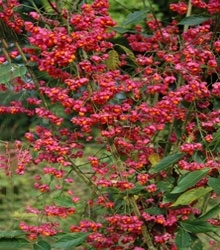Spindle
 If you walk in late autumn along a hedgerow or woodland edge that grows on lime rich soils, you may well come across one of nature’s great colour clashes, the sort that your art teacher would have no doubt frowned upon if you had dared to chose to mix two such vibrant colours together. As the spindle tree’s leaves turn a purplish red at this time of year, it also produces bright pink berries that hang in clusters from its branches that in themselves are quite spectacular, but the real surprise is that slowly each one will split open to reveal vivid orange seeds within, truly breaking all the rules of colour coordination!
If you walk in late autumn along a hedgerow or woodland edge that grows on lime rich soils, you may well come across one of nature’s great colour clashes, the sort that your art teacher would have no doubt frowned upon if you had dared to chose to mix two such vibrant colours together. As the spindle tree’s leaves turn a purplish red at this time of year, it also produces bright pink berries that hang in clusters from its branches that in themselves are quite spectacular, but the real surprise is that slowly each one will split open to reveal vivid orange seeds within, truly breaking all the rules of colour coordination!
Spindle gets its name due to the fact that its creamy white, very dense hard wood was ideal for making spindles for the spinning of raw wool. The arrow straight and surprisingly strong, heavy twigs of spindle were also widely used for making knitting needles, skewers (especially for meat as they leave no taint) and even toothpicks. Nowadays, the only use for the wood is that some people still produce specialist high-quality charcoal from it for the artist market.
The spectacular garish fruits are in fact poisonous, although it is thought that birds consume them and distribute the seeds around within their droppings. The poison was considered useful though in days gone by as the berries were collected, baked and powdered and then used to treat lice-infested human heads and also mange in cattle and dogs. John Gerard, the English herbalist wrote: “If three or four of these fruits be given to a man, they purge both by vomit and stool”. To “purge” the body of impurities used to be a common medicinal practice.
Some farmers and gardeners, however, don’t like the plant at all and will occasionally destroy it and would certainly not include it in any new plantings. This is because the black bean aphid lays its eggs on spindle, which then over-winter hidden amongst the twigs. The eggs hatch from late February to early April and colonies rapidly develop on the young spindle leaves. The winged form of aphid, which can be a major agricultural pest, is produced in May and June, and these migrate onto an enormous range of summer hosts, including field beans, sugar beet and maybe your garden broad beans or tomatoes!
It is not all bad, though, as the spindle is also the host plant of certain moths that include the magpie moth, the wonderfully named scorched carpet moth, and also the spindle ermine moth, which creates a web that can completely envelop the whole tree, leaving the little caterpillars, safe within their webbed canopy, to munch away on the spindle’s leaves! The beautiful little holly blue butterfly also occasionally chooses spindle to lay its eggs on.
So, the little Spindle tree may not grow much more than 3 or 4 metres tall, but it certainly knows how to get itself noticed in the autumn by producing the most outrageously coloured berries you are ever likely to come across!
Peter Thompson
Advisory

Download Peter Thompson's essential 26-page book, featuring beautiful photography and detailed profiles of Britain's wildlife
Download FREE >